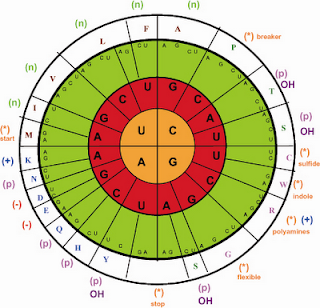 Genetic code is universal and does not undergo any change. But during 1980s, it was discovered that the genetic code of mitochondria of yeasts, Drosophila and mammals differs from the universal genetic code. The mitochondrial genome is usually circular DNA molecule and contains complete genetic system. Anderson et al for the first time through DNA sequencing technique presented the complete sequence of 16,569 nuclear, of human mitochondrial genome. The human mitochondrial genome differs from that of nuclear, chloroplast and bacterial genome in the following respect:
Genetic code is universal and does not undergo any change. But during 1980s, it was discovered that the genetic code of mitochondria of yeasts, Drosophila and mammals differs from the universal genetic code. The mitochondrial genome is usually circular DNA molecule and contains complete genetic system. Anderson et al for the first time through DNA sequencing technique presented the complete sequence of 16,569 nuclear, of human mitochondrial genome. The human mitochondrial genome differs from that of nuclear, chloroplast and bacterial genome in the following respect:(i) Unlike others, every nucleotide appears to be a part of coding sequence.
(ii) The normal codon-anticodon pairing rules are relaxed in mitochondria, therefore, many there are 22 t RNAs in mitochondria and about 55 t RNAs in universal code.
(iii) The genetic code is different from those of the same codons in other genomes. However, the genetic code of mitochondria differs from the universal genetic code on the other hand the mitochondrial genetic code in different group of organisms also differ. For example, UGA which is a stop codon elsewhere is read as tryptophan in mitochondria of yeasts, Drosophila, mammals and protozoa, but as stop codon in mitochondria. The codon AGG normally codes for arginine, but it acts as stop codon in mitochondria of mammals, and codes for serine in Drosophila, UGA codon which codes for isoleusine, specifies methionine in yeasts, Drosophila and mammal’s mitochondria.















